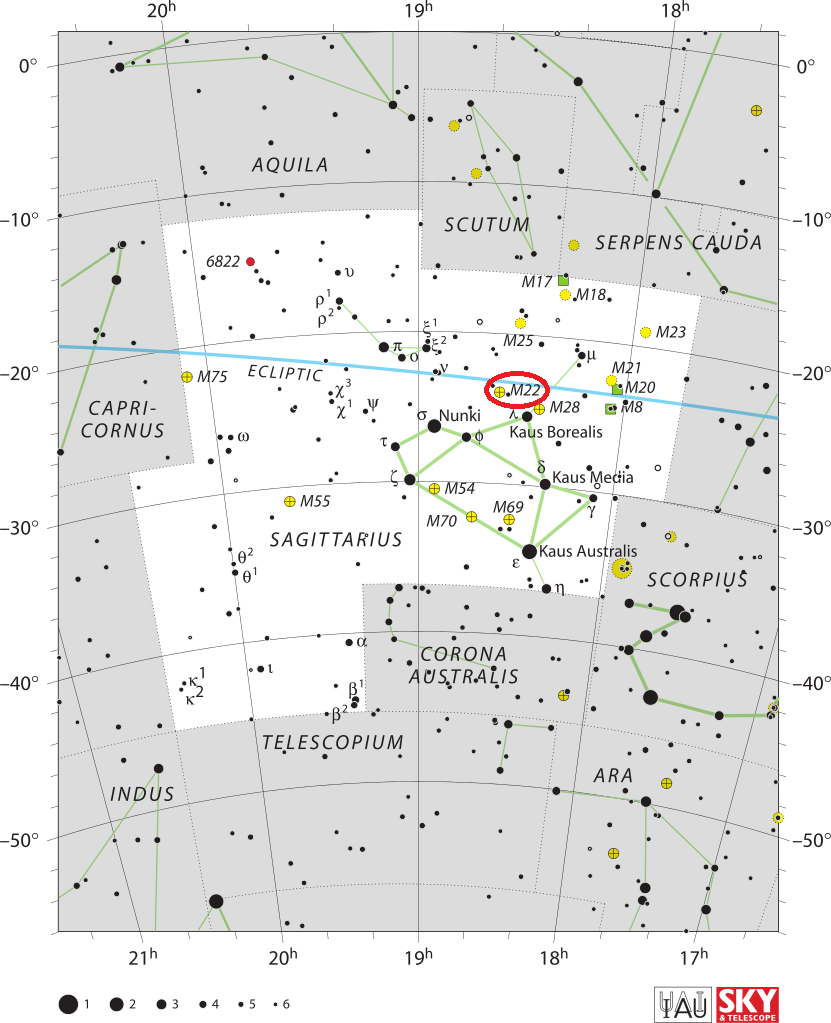Messier 22 (M22) is a globular cluster located near the Milky Way bulge, the tightly packed group of stars near the galactic centre. The cluster lies in the constellation Sagittarius. It is one of the brightest globular clusters in the sky and was one of the first objects of this kind to be discovered and studied.
M22 is also one of the nearest globulars to the solar system. The only globular cluster closer to us is Messier 4, located in the neighbouring constellation Scorpius. M22 is elliptical in shape and lies at a distance of 10,600 light years from Earth. Its designation in the New General Catalogue is NGC 6656.
With a visual magnitude of 5.5, M22 is the brightest globular cluster visible from the mid-northern latitudes. However, as it lies in the southern constellation Sagittarius, M22 never rises very high in the sky and can’t really be observed in all its glory from the northern hemisphere. It doesn’t offer a view as impressive as those of Messier 13 in Hercules and Messier 5 in Serpens.
The constellations Hercules and Serpens are both found in the northern celestial hemisphere and are higher in the sky for northern observers, which makes the deep sky objects located within their boundaries much easier to observe.
Messier 22 is easy to find. Visible to the naked eye in good conditions, the cluster lies only 2.5 degrees to the northeast of Kaus Borealis, the star that marks the top of the Teapot in Sagittarius. In binoculars, M22 appears as a faint patch of light. Small telescopes will resolve the brightest stars and larger instruments will reveal stars across the cluster.
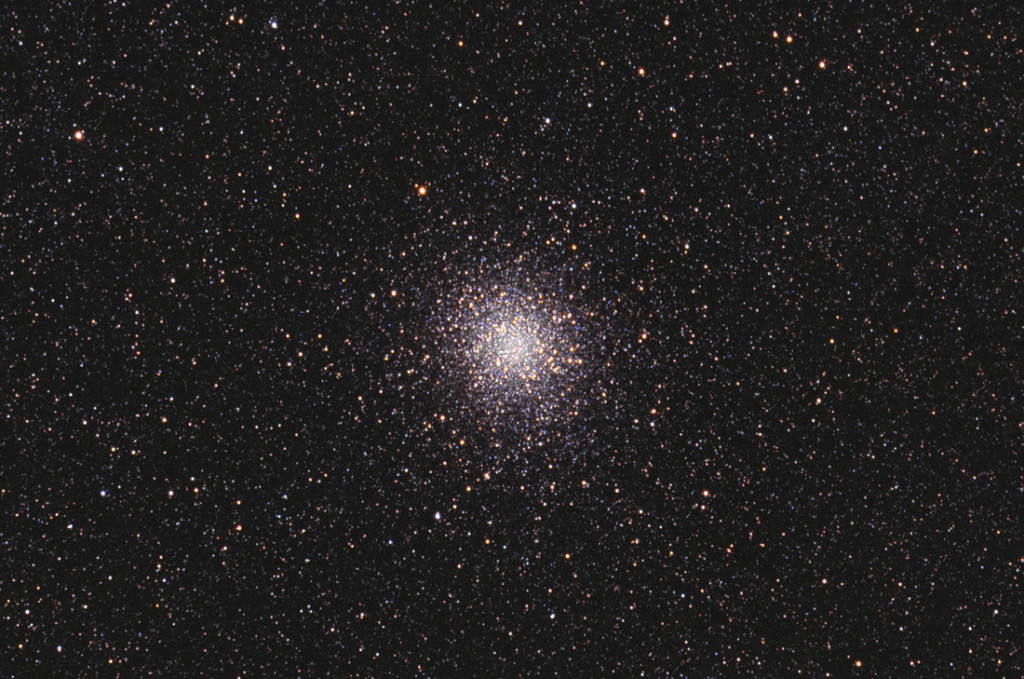
The best time of year to observe M22 is in June, July and August, when Sagittarius can be seen over the southern horizon in the evening.
The estimated age of M22 is 12 billion years. The cluster occupies an area of 32 arc minutes in the sky, which is slightly larger than the size of the full Moon, and corresponds to a linear diameter of 99 light years. The only globular clusters brighter than M22 are Omega Centauri in the constellation Centaurus and 47 Tucanae in Tucana. Neither of these clusters was included in the Messier catalogue because they are too far south to be visible from most northern locations.
M22 is receding from us at 149 km/s. The cluster contains at least 83,000 stars and has a combined mass of 500,000 Suns. The brightest stars are of magnitude 11. The cluster is known to contain 32 variable stars.
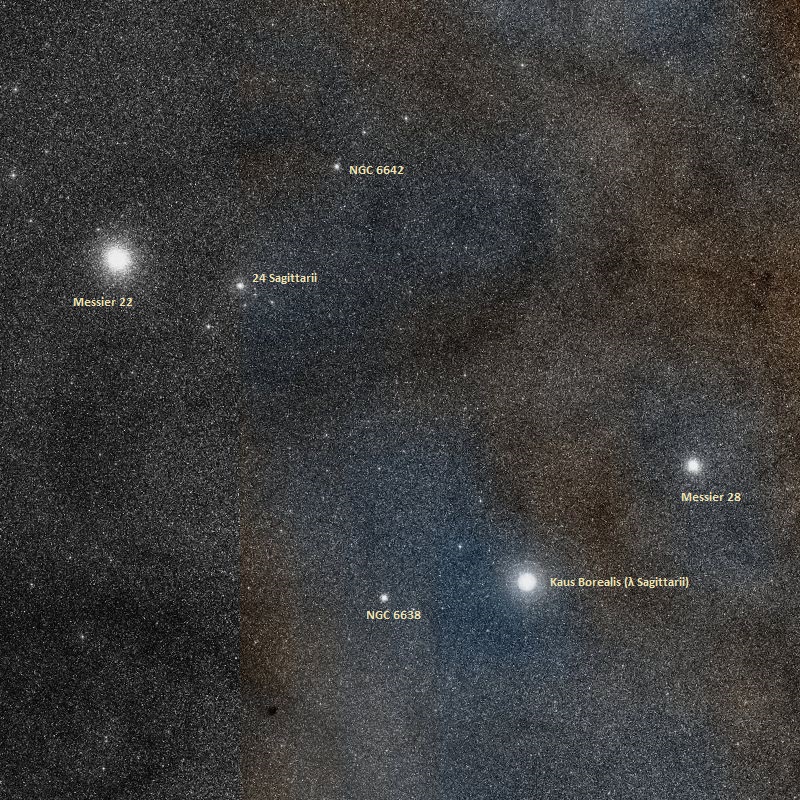
Two black holes were discovered in M22 and confirmed by the Chandra X-ray telescope in 2012. The objects have between 10 and 20 solar masses. Their discovery suggests that there may be between 5 and 100 black holes within the cluster and that multiple black holes may exist in other clusters as well. The presence of black holes and their interaction with the stars of M22 could explain the cluster’s unusually large central region.
The two black holes, designated M22-VLA1 and M22-VLA2, are both part of binary systems. Each has a companion star and is pulling matter from it. The stolen material – gas and dust – forms an accretion disk around each black hole and emissions from these disks are what scientists were able to detect. Without them, the black holes would have stayed hidden.
Messier 22 is one of only four globular clusters that contain a planetary nebula. The only other globular listed in Messier’s catalogue known to have a planetary nebula is Messier 15, located in the constellation Pegasus.
The nebula in M22, catalogued as GJJC1 or IRAS 18333-2357, was discovered by the infrared satellite IRAS in 1986 and identified as a planetary nebula in 1989. The nebula is only 3 arc seconds in diameter and lies 1 arc minute to the south of the cluster’s centre. It is extremely difficult for observers to find. The nebula has an estimated age of only 6,000 years and has a blue star at its core.
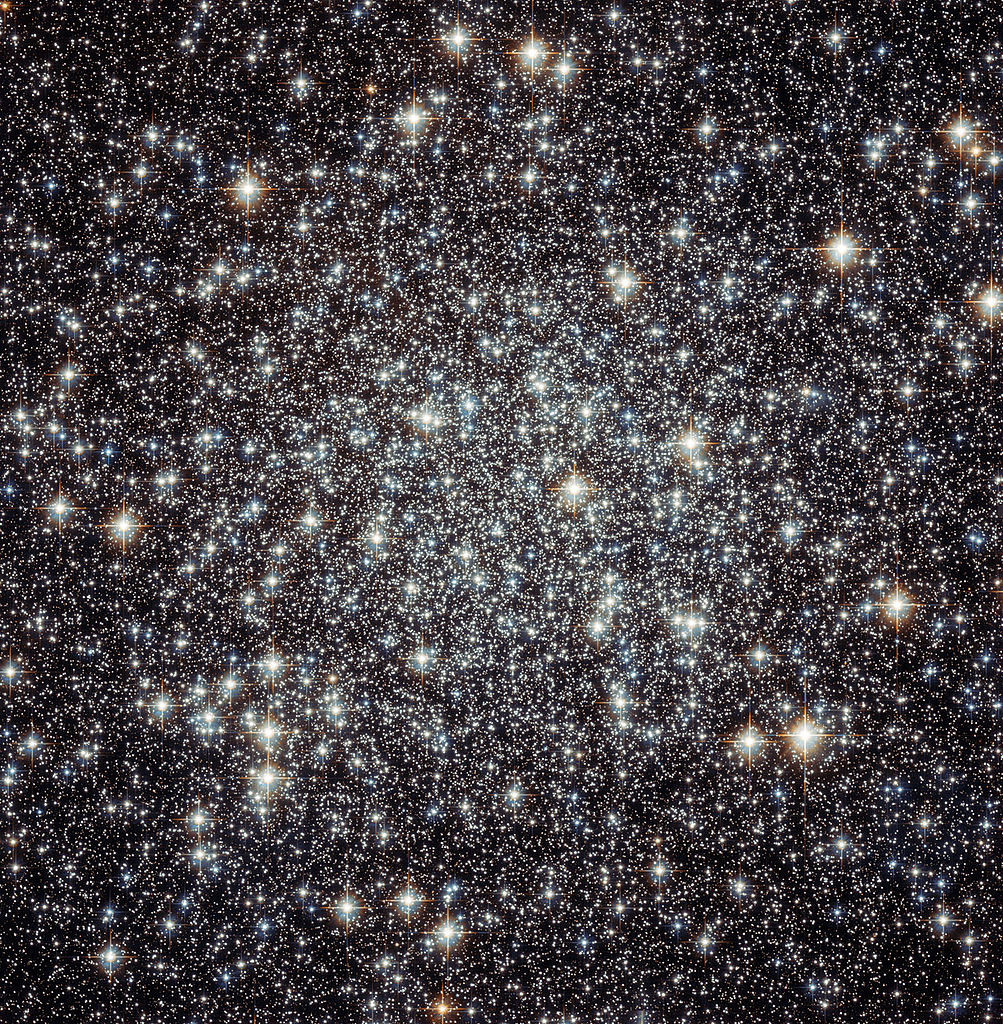
Messier 22 orbits the Milky Way centre once every 200 million years. The cluster’s position, in front of the galactic bulge, is useful to scientists as M22 has a gravitational microlensing effect on the stars in the bulge, located behind the cluster.
The lensing effect is a phenomenon that occurs when an astronomical object such as a star or a quasar is aligned with a massive object in the foreground – in this case, a cluster – and the light of the first object is bent due to the gravitational field of the massive object. As a result, the background object can appear in two or more distorted, unresolved, magnified, brightened images near the object in the foreground. The phenomenon allows astronomer to study a range of dark or faint objects, including brown, white and red dwarfs, planets, neutron stars and black holes.
In 1999, a survey with Hubble’s Wide Field and Planetary Camera 2 revealed six planet-sized objects with masses about 80 times that of our planet. These objects were discovered after the space telescope had recorded brief microlensing events while monitoring the stars in M22.
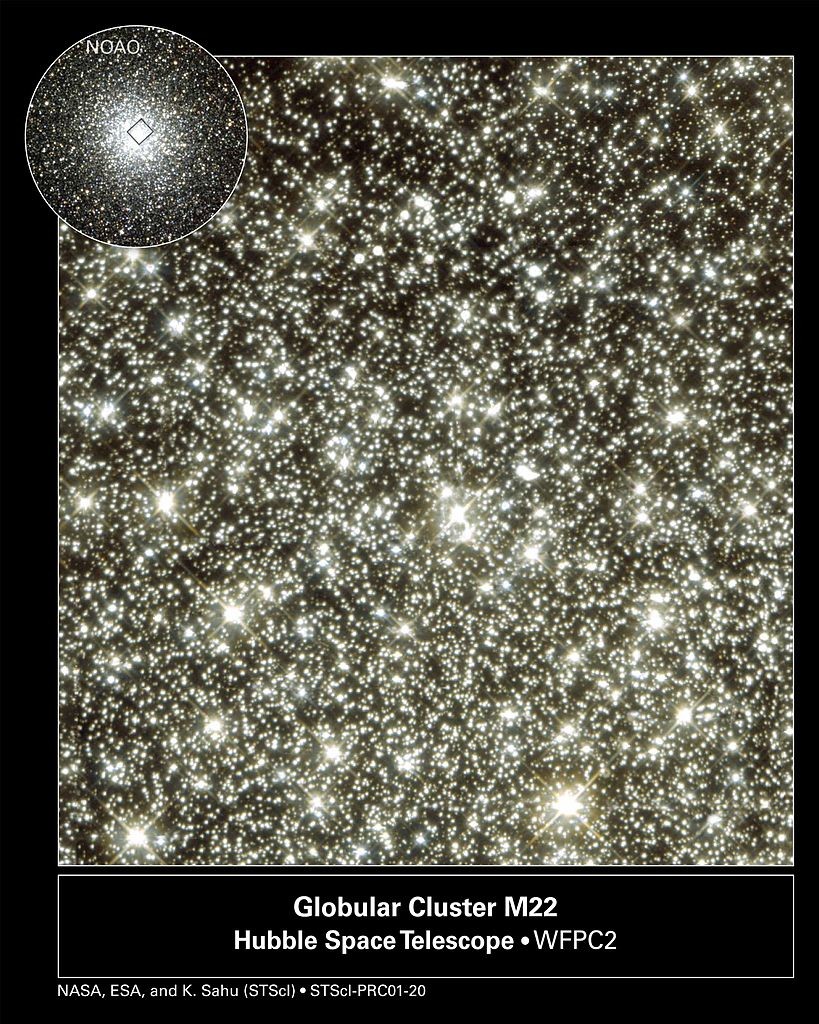
The stars near the cluster’s core are 100,000 times more numerous than those in the Sun’s neighborhood. Buried in the glow of starlight are about six “mystery objects,” which astronomers estimate are no larger than one quarter the mass of the giant planet Jupiter, the solar system’s heftiest planet. The mystery objects are too far and dim for Hubble to see directly. Instead, the orbiting observatory detected these unseen celestial bodies by looking for their gravitational effects on the light from far distant stars. In this case, the stars are far beyond the cluster in the galactic bulge, about 30,000 light-years from Earth at the center of the Milky Way Galaxy. M22 is 8,500 light-years away. The invisible objects betrayed their presence by bending the starlight gravitationally and amplifying it, a phenomenon known as microlensing.
From February 22 to June 15, 1999, Hubble’s Wide Field and Planetary Camera 2 looked through this central region and monitored 83,000 stars. During that time the orbiting observatory recorded six unexpectedly brief microlensing events. In each case a background star jumped in brightness for less than 20 hours before dropping back to normal. These transitory spikes in brightness mean that the object passing in front of the star must have been much smaller than a normal star. Hubble also detected one clear microlensing event. In that observation a star appeared about 10 times brighter over an 18-day span before returning to normal. Astronomers traced the leap in brightness to a dwarf star in the cluster floating in front of the background star.
The inset photo shows the entire globular cluster of about 10 million stars. M22 is about 60 light-years wide. The image was taken in June 1995 by the Burrell Schmidt telescope at the Case Western Reserve University’s Warner and Swasey Observatory on Kitt Peak in Arizona. Credits for the Hubble image: NASA, Kailash Sahu, Stefano Casertano, Mario Livio, Ron Gilliland (Space Telescope Science Institute), Nino Panagia (European Space Agency/Space Telescope Science Institute), Michael Albrow and Mike Potter (Space Telescope Science Institute)
Credits for ground-based image: Nigel A.Sharp, REU program/AURA/NOAO/NSF
Messier 22 was discovered by Abraham Ihle, a German amateur astronomer, on August 26, 1665. Ihle stumbled upon the cluster while observing Saturn. M22 is probably the first globular cluster to have been discovered. As it lies very close to the ecliptic, planets often come very close to it, which is how Ihle discovered it.
Charles Messier included the cluster in his catalogue on June 5, 1764 with the following note:
In the same night of June 5 to 6, 1764, I have observed a nebula situated a bit below the ecliptic, between the head & the bow of Sagittarius, near the star of seventh magnitude, the twenty-fifth of that constellation, according to the catalog of Flamsteed. That nebula didn’t appear to me to contain any star, although I have examined it with a good Gregorian telescope which magnified 104 times: it is round, & one sees it very well with an ordinary [non-achromatic] refractor of 3 feet & a half; its diameter is about 6 minutes of arc. I have determined its position by comparing with the star Lambda Sagittarii: its right ascension has been concluded as 275d 28′ 39″, & its declination as 24d 6′ 11″. It was Abraham Ihle, a German, who discovered this nebula in 1665, when observing Saturn. M. le Gentil has examined it also, & he has made an engraving of the configuration in the volume of the Memoirs of the Academy, for the year 1759, page 470. He observed it on August 29, 1747, under good weather, with a refractor of 18 feet length: He also observed it on July 17, & on other days. “It always appeared to me,” he says, “very irregular in its figure, hair & distributing in space of rays of light all over its diameter.”
William Herschel resolved the cluster into stars with his 20-foot telescope in July 1783. He provided the following observation: “With a small 20-feet Newtonian telescope, power 200, it is all resolved into stars, that are very small and close. There must be some hundreds of them. With 350, I see the stars very plainly; but the nebula is too low in this latitude for such a power.”
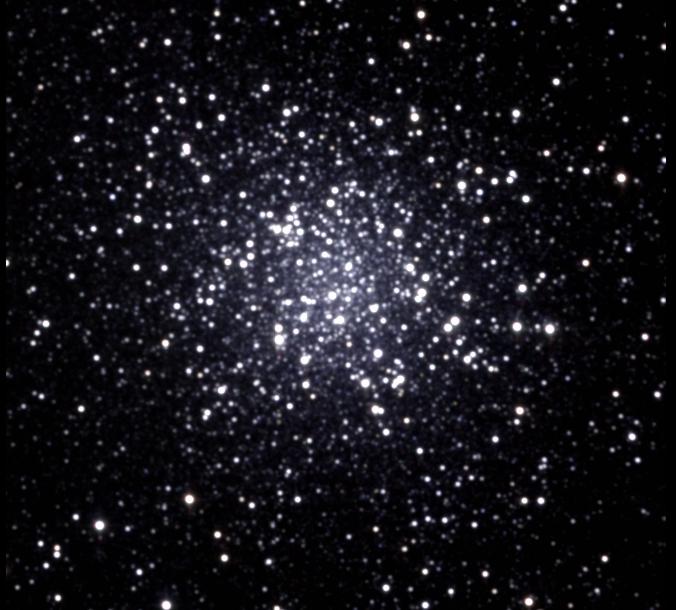
Admiral William Henry Smyth observed M22 in July 1835 and offered the following description of the cluster:
A fine globular cluster, outlying that astral stream, the Via Lactea [Milky Way], in the space between the Archer‘s head and bow, not far from the point of the winter solstice, and midway between Mu and Sigma Sagittarii. It consists of very minute and thickly condensed particles of light, with a group of small stars preceding by 3m, somewhat in a crucial form. Halley ascribes the discovery of this in 1665, to Abraham Ihle, the German; but it has been thought this name should have been Abraham Hill, who was one of the first council of the Royal Society, and was wont to dabble with astronomy. Hevelius, however, appears to have noticed it previous to 1665, so that neither Ihle nor Hill can be supported.
In August, 1747, it was carefully drawn by Le Gentil, as seen with an 18-foot telescope, which drawing appears in the Mémoires de l’Académie for 1759. In this figure three stars accompany the cluster, and he remarks that two years afterwards he did not see the preceding and central one: I, however, saw it very plainly in 1835. In the description he says, “Elle m’a toujours parue tres-irrégulière dans sa figure, chevelue, et rependant des espèces de rayons de lumière tout autout de son diamètre.” This passage, I quote, “as in duty bound;” but from familiarity with the object itself, I cannot say that I clearly understand how or why his telescope exhibited these “espèces de rayons.” Messier, who registered it in 1764, says nothing about them, merely observing that it is a nebula without a star, of a round form; and Sir William Herschel, who first resolved it, merely describes it as a circular cluster, with an estimated profundity of the 344th order. Sir John Herschel recommends it as a capital test for trying the space-penetrating power of a telescope.
This object is a fine specimen of the compression on which the nebula-theory is built. The globular systems of stars appear thicker in the middle than they would do if these stars were all at equal distances from each other; they must, therefore, be condensed toward the centre. That the stars should be accidentally disposed is too improbable a supposition to be admitted; whence Sir William Herschel supposes that they are thus brought together by their mutual attractions, and that the gradual condensation towards the centre must be received as proof of a central power of such kind.
Messier 22 was one of the first globulars to be extensively studied. American astronomer Harlow Shapley, who studied M22 in 1930, found around 70,000 member stars in the cluster and discovered that M22 had a dense core.
American astronomers Halton Arp and William G. Melbourne studied the cluster in 1959, and a team led by James E. Hesser conducted extensive surveys of M22 in 1977 to examine the large colour spread of the cluster’s red giant branch (RGB) sequence, similar to the one seen in Omega Centauri (NGC 5139), the largest known globular cluster in the Milky Way.
FACTS
|
LOCATION
